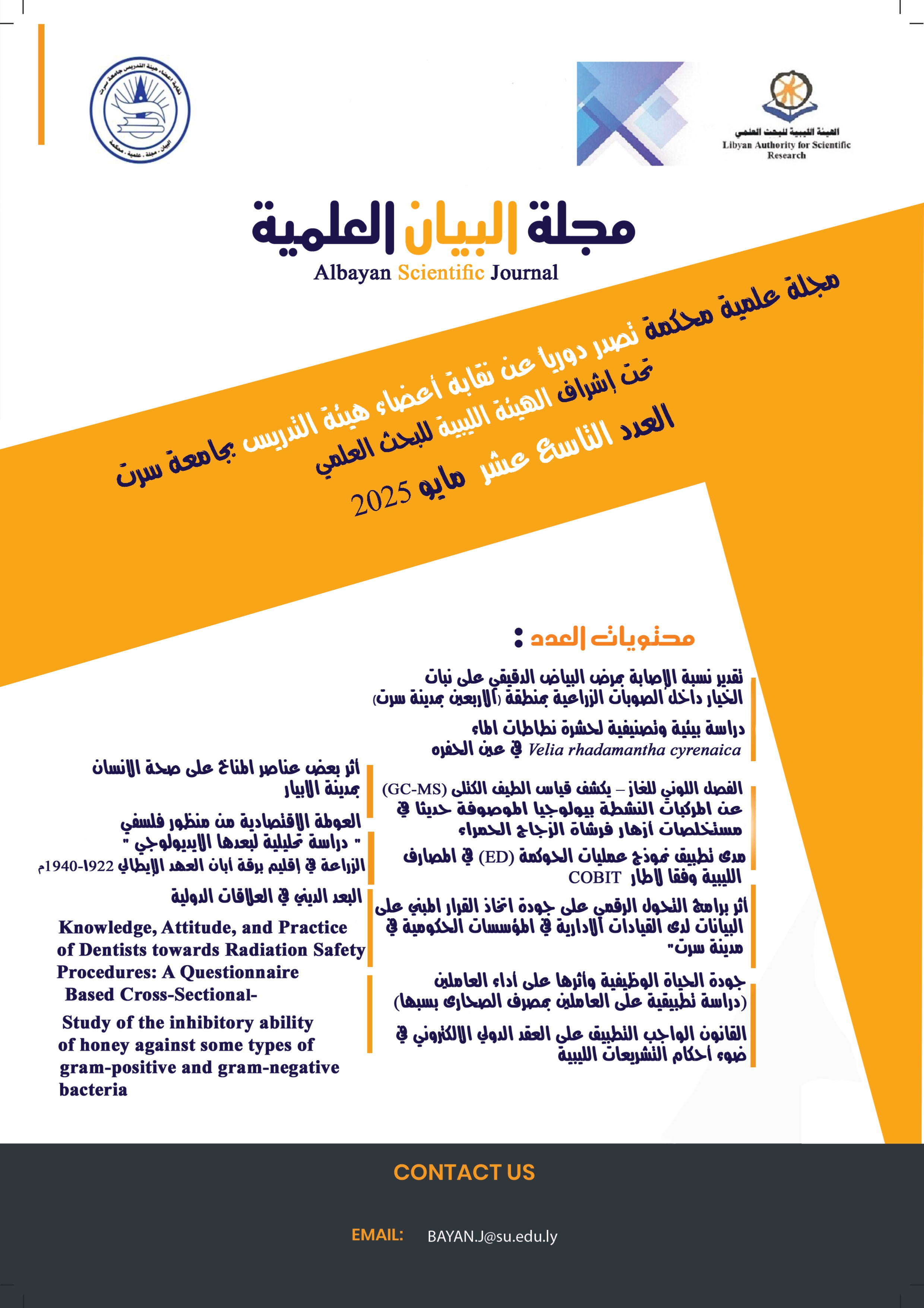Study of the inhibitory ability of honey against some types of gram- positive and gram-negative bacteria
DOI:
https://doi.org/10.37375/bsj.v7i19.3313Keywords:
coli, Staphylococcus aureus, Honey, antibacterial activity of honey, Tobruk universityAbstract
The objective of this research was to examine the antimicrobial properties of a honey sample against specific microbial isolates. Various concentrations (50% and 100%) of the honey sample were evaluated for their antimicrobial effects on several medically significant microorganisms, including Escherichia coli and Staphylococcus aureus. The minimum inhibitory concentrations (MIC) of the honey sample were established for the selected microorganisms through the diffusion method. The honey sample exhibited an inhibitory effect in vitro at both 50% and 100% concentrations on the different microorganisms studied. The findings indicate that honey possesses antimicrobial properties similar to those of antibiotics, demonstrating sensitivity in certain organisms and offering a potential alternative treatment against specific bacterial infections. Additionally, it has been shown to exert antimicrobial activity against a wide range of bacteria, encompassing both gram-positive and gram-negative strains.
References
Abuharfeil N, Al-Oran R, Abo-Dhehada M (1999). The effect of bee honey on the proliferative activity of human B- and T-lymphocytes and the activity of phagocytosis. Food Agric. Immunol. 11: 169-177.
Akmatov, M. K., Mehraj, J., Gatzemeier, A., Stro¨mpl, J., Witte, W., Krause, G., Pessler, F. (2010). Serial home-based self-collection of anterior nasal swabs to detect Staphylococcus aureus carriage in arandomized population-based study in Germany. International Journal of Infectious Disease , 25, 4-10.
Alamanni , M. C.; Juliano , C.; Floris. I. and Marras. P.M. (1992). Invetro anti-bacterial activity and pollen spectrum of Sardination bitter honey. Rivista della Societa Italiana discienza dell Alimenta Ziona. 21(4): 535-543.
Baos Muñoz, Elvira. (2016). Caracterización y seguimiento de la resistencia a linezolid en staphylococcus epidermidis en la unidad de cuidados intensivos del Hospital Clínico San Carlos tras la descripción del primer brote de staphylococcus aureus linezolid resistente.
Behzad, M.N., Akhi, M.T., Alizadeh, M., Saleh, P., Jafarzadeh, S., Navi, Z.S., Bagheri, M.M., Barband, S., Sadeghi, G., Asghari, B. (2015). Staphylococcus aureus: resistance pattern and risk factors. Journal of Analytical Research in Clinical Medicine , 3 (1), 43-50.
Bexiga, R .; Koskinen, M.T.; Holopainen, J.; Carneiro, C.; Pereira, H.; Ellis, K.A. and Vilela, C.L. ( 2011) . Diagnosis of intramammary infection in samples yielding negative results or minor pathogens in conventional bacterial culturing. J. Dairy Res., 78:49–55.
Bilal AN, Molan PC, Sallal AK (1998). Antimicrobial activity of honey on selected microorganisms: A preliminary study. Biomed. Res. (India). 9: 51-54.
Campbell NA, Reece JB. Biology(2002). San Francisco: Pearson Education Inc.
Chick HHS, Shin Z (2001). Ustunol, Growth and acid production by lactic acid bacteria and bifidobacteria grown in skim milk containing honey., J. Food Sci. 66: 478–481.
David, M. Z., & Daum, R. S. (2010). Community-associated methicillin-resistant Staphylococcus aureus. Clinical Microbiolgy Reviews , 23, 616–687.
Drasar B S, Hill M J (1974). Human intestinal flora. London, United Kingdom: Academic Press. pp. 36–43.
Dustmann JH (1979). Antibacterial effect of honey. Apiacta. 14(1): 7-11.
Eckburg PB, Bik EM, Bernstein CN, Purdom E, Dethlefsen L, Sargent M, et al(2005). Diversity of the human
intestinal microbial flora. Science. 308(5728):1635-1638.
El-Sukhon SN, Abu-Harfeil N, Sallal AK (1994). Effects of honey on Bacterial Growth and Spore Germination. J. Food Prot. 57(10): 918- 920.
Enger ED, Ross FC(2003). Concepts in Biology. 10th ed. New York, USA. Available from: http://hyperphysics.phy-astr.gsu.edu/hbase/Biology/ecoli.html
Kiprioanoveska, H.; Ziberoski, J. and Naumovski. M. (1998). Microbiological status of the honey Year book of the faculty of Agriculture. 43(1): 125-129.
Klein, E. Y., Mojica, N., Jiang, W., Cosgrove, S. E., Septimus, E., Morgan, D. J., et al. (2017). Trends in methicillin-resistant Staphylococcus aureus hospitalizations in the United States, 2010–2014. Clin. Infect. Dis. 65, 1921–1923. doi: 10.1093/cid/cix640.
Klevens, R. M., Morrison, M. A., Nadle, J., Petit, S., Gershman, K., Ray, S., et al. (2007). Invasive methicillin-resistant Staphylococcus aureus infections in the United States. JAMA 298, 1763–1771. doi: 10.1001/jama.298.15.1763.
Korzeniewska , E.; Korzeniwska, A. and Harnisz, M.(2013). Antibiotic resistant
Escherichia coli in hospital and municipal sewage and their emission to the environment.
Ecotoxicol. Environ. Saf. 91:96-102.
Lakhundi, S., and Zhang, K. (2018). Methicillin-Resistant Staphylococcus aureus: molecular characterization, evolution, and epidemiology. Clin. Microbiol. Rev. 31:e00020–18. doi: 10.1128/CMR.00020-18.
Lessa, F. C.,Mu, Y., Ray, S.M., Dumyati, G., Bulens, S., Gorwitz, R. J., et al. (2012). Impact of USA300 methicillin-resistant Staphylococcus aureus on clinical outcomes of patients with pneumonia or central line-associated bloodstream infections. Clin. Infect. Dis. 55, 232–241. doi: 10.1093/cid/cis408.
Lindsay, J. A. (2013). Hospital-associated MRSA and antibiotic resistance-what have we learned from genomics? Int. J. Med. Microbiol. 303, 318–323.
Mandal MD, Mandal S. Honey: its medicinal property and antibacterial activity. Asian Pac J Trop Biomed. 2011 Apr;1(2):154-60. doi: 10.1016/S2221-1691(11)60016-6. PMID: 23569748; PMCID: PMC3609166.
Mediavilla, J. R., Chen, L., Mathema, B., and Kreiswirth, B. N. (2012). Global epidemiology of community-associated methicillin resistant Staphylococcus aureus (CA-MRSA). Curr. Opin. Microbiol. 15, 588–595.
Molan P (1992). The antibacterial activity of honey 1. The nature of the antibacterial activity. Bee World. 1: 5-28.
Molan PC (1995). The antibacterial properties of honey. Chem in NZ, pp 10 – 14.
Molan PC (2001). Why honey is effective as a medicine. 2. The scientific explanation of its effects. Bee World 82(1): 22-40.
Molane. P.C.; smith. I. M. and Reid. G. M. (1988). Acomporision of antibacterial activity of some Newzealand honeys. J. Api. Res. 27(4): 252-256.
Nielsen, K.L., Dynesen, P.; Larsen, P. and Frimodt-Moller, N. (2014). Faecal Escherichia coli from patients with Escherichia coli urinary tract infection (UTI) and other honey. Pharm. Sci. 2: 1-3.
Otto, M. (2013). Community-associated MRSA: what makes them special? Int. J. Med. Microbiol. 303:324–330. doi: 10.1016/j.ijmm.2013.02.007.
Ouidri, M. A. (2018). Screening of nasal carriage of methicillin-resistant Staphylococcus aureus during admission of patients to Frantz Fanon Hospital. New Microbes and New Infections , 23, 52–60.
Pena,I,; Picazo, J.J; Rodriguez-Avial, C.; Rodriguez-Avial, I. (2014). Carbapenemase-producing Enterobacteriaceae in a tertiary hospital in Madrid, Spain: high percentage of colistin resistance amongVIM-1 -producing Klebsiella pneumoniae ST11 isolates. Int. J. Antimicrob . Agents. 43(5):460 - 464.
Pichereau, S., and Rose, W. E. (2010). Invasive community-associated MRSA Postmes T, Van den Bogaard AE, Hazen M (1993). Honey for wounds, ulcers and skin graft preservation. Lancet. 341: 756-757.
Quinn PJ, Carter ME, Markey BK, Carter GR (1994). Enterobactereaceae. In Clinical veterinary microbiology. Wolfe Publishing, an imprint of Mosby-Year Book Europe Ltd. London. pp. 109-135.
Rao, Q., Weilong, S., Xiaomei, H., and Xiancai, R. (2015). "Staphylococcus aureus ST121: a globally disseminated hypervirulent clone. Journal of Medical Microbiology ,64, 1462–1473.
Rayner, C., and Munckhof, W. J. (2005). Antibiotics currently used in the treatment of infections caused by Staphylococcus aureus. Intern. Med. J. 35(Suppl 2):S3–16. doi: 10.1111/j.1444-0903.2005.00976.x.
Ruiz- Argues. T. and Rodriguz – Navarro. A. (1973). Gluconic acid producing bacteria from honey bees and ripening honey. J. Gen. Microbiol. 76:211-216.
Salas, D. E., Minejima, E., Joanna.W., Fang, C., Wang, J., Rosemary,S., Nieberg, P., Wong-Beringer, A. (2017). Staphylococcus aureus bacteremia in patients not meeting sepsis criteria:clinical features, host immune response and outcomes. Journal of Clinical Medicine and Therapeutics , 2(4), 1-7.
Schulte, R. H., andMunson, E. (2019). Staphylococcus aureus resistance patterns in wisconsin: 2018 surveillance of wisconsin organisms for trends in antimicrobial resistance and epidemiology (SWOTARE) program report. Clin. Med. Res. 17, 72–81. doi: 10.3121/cmr.2019.1503.
Shang,W., Hu, Q., Yuan,W., Cheng, H., Yang, J., Hu, Z., et al. (2016). Comparative fitness and determinants for the characteristic drug resistance of ST239-MRSAIII- t030 and ST239-MRSA-III-t037 strains isolated in China. Microb. Drug. Resist. 22, 185–192. doi: 10.1089/mdr.2015.0226
Snowdon JA, Cliver DO (1996). Microorganisms in honey. International J. Food Microbiol. 31: 1-26.
White, J. W. (1993). Honey: In the hive and honey be Dadant and sons inc. Hamilton. U.S.A 869-925PP.
Willix DJ, Molan PC, Harfoot CG (1992). A comparision of the sensitivity of wound-infecting species of bacteria to the antibacterial activity of Manuka honey and other honey. J. Appl. Bacteriol. 73(5): 388-394.














